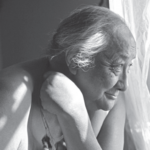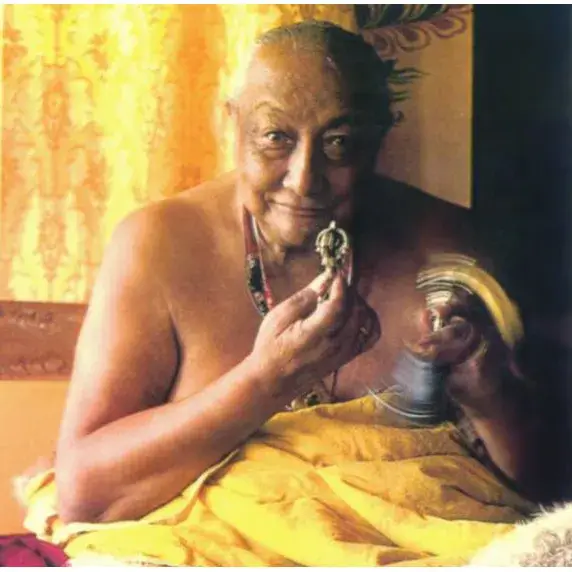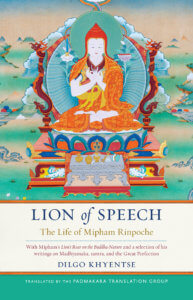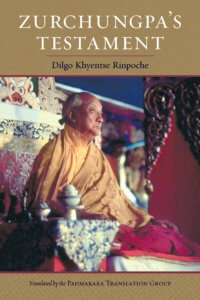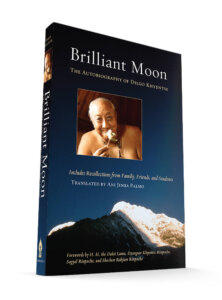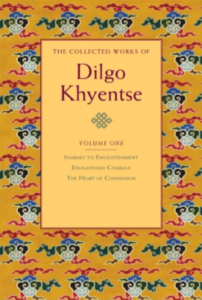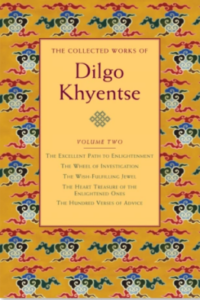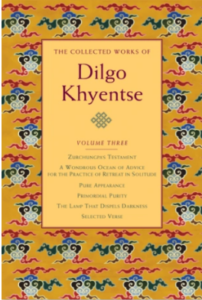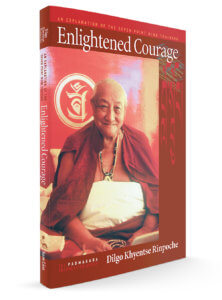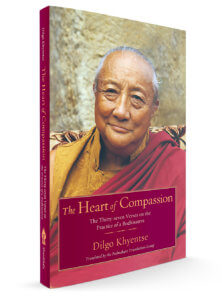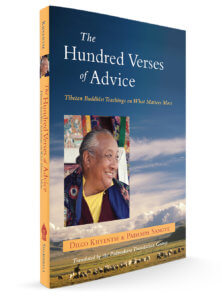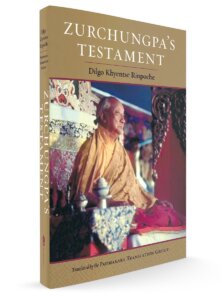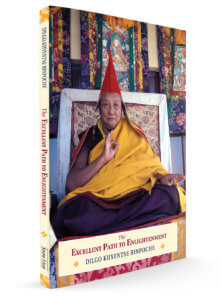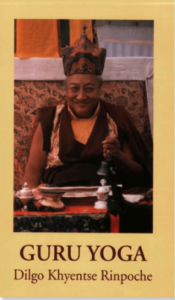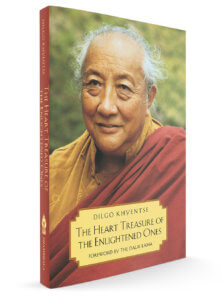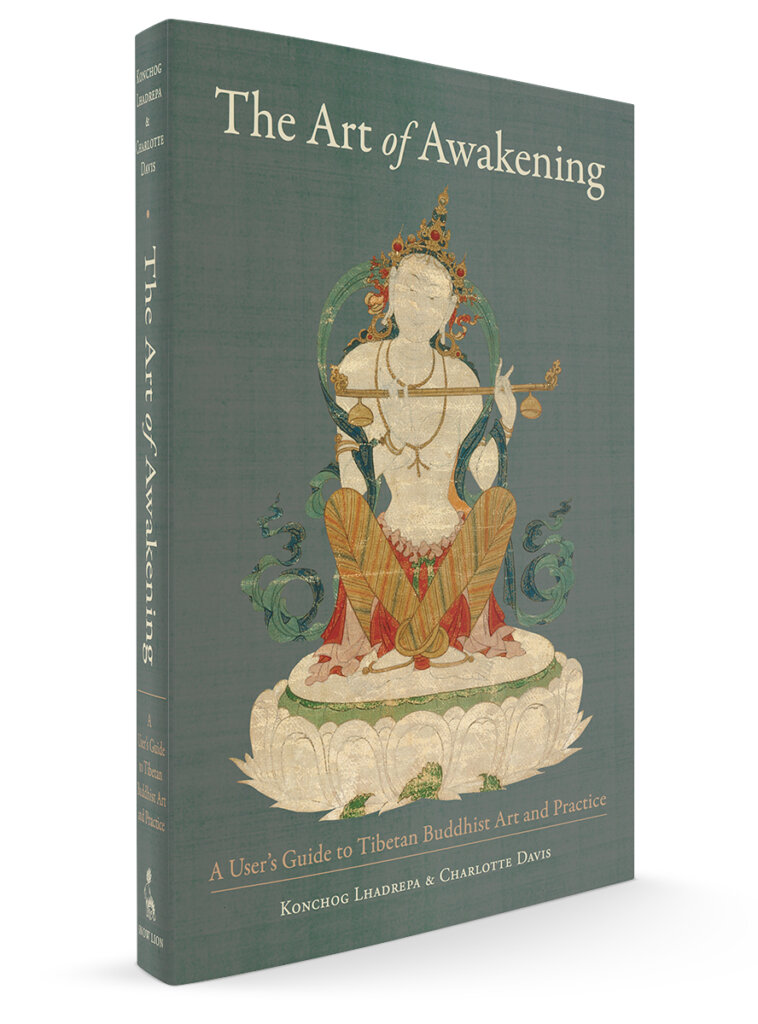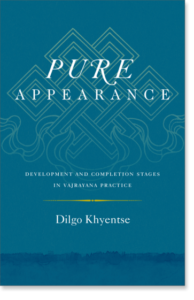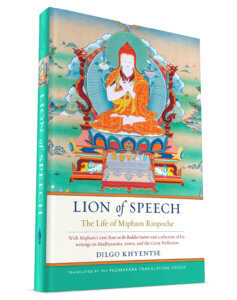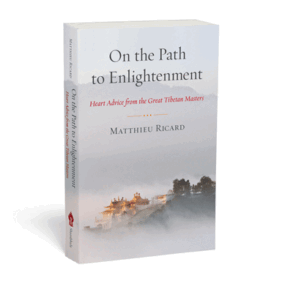Explore Nyingma Lineages: Dudjom Tersar | Longchen Nyingtig | Namcho & Palyul
Guides to Important Nyingma Figures:
Rongzompa | Longchenpa | Jigme Lingpa | Patrul Rinpoche |
Sera Khandro | Mipham Rinpoche | Dilgo Khyentse Rinpoche | Dudjom Rinpoche | Thinley Norbu Rinpoche
Dilgo Khyentse Rinpoche (1910–1991) was a highly accomplished meditation master, scholar, and poet, and a principal holder of the Nyingma lineage. His extraordinary depth of realization enabled him to be, for all who met him, a foundation of loving-kindness, wisdom, and compassion. A dedicated exponent of the nonsectarian Rime movement, Khyentse Rinpoche was respected by all schools of Tibetan Buddhism and taught many eminent teachers, including His Holiness the Dalai Lama. He tirelessly worked to uphold the Dharma through the publication of texts, the building of monasteries and stupas, and by offering instruction to thousands of people throughout the world. His writings in Tibetan fill twenty-five volumes.
Khyentse Rinpoche was born in 1910 to the family of Dilgo in eastern Tibet near Dege on the day that Mipham Rinpoche was there completing a ganachakra feast offering after six weeks of teaching. Shortly afterward he blessed and named the infant Tashi Paljor. Though Khyentse Rinpoche was only two when Mipham passed away, the latter's impact on him was immense, as it was for so many in Eastern Tibet. Throughout his life, Khyenste Rinpoche taught extensively from Mipham Rinpoche's teachings, as we will see in a few examples below.
While still an infant, he was recognized as the tulku of Jamyang Khyentse Wangpo, and when he was fourteen, he went to Shechen Monastery where he was enthroned as Khyentse Wangpo's tulku by Shechen Gyaltsap. Over the next four years he was immersed in study and practice of Sutra, Tantra, and Dzogchen, primarily with Shechen Gyaltsap and Jamyang Khyentse Chokyi Lodro, but also with Khenpo Shenga, Adzom Drukpa, and many more.
Throughout his life, Rinpoche had over sixty teachers from all the main schools of Tibetan Buddhism.
A few years later, Shechen Gyaltsap passed away, and the eighteen year old Dilgo Khyentse Rinpoche went into solitary retreat for the next thirteen years, mostly living and practicing in caves in Eastern Tibet. After he emerged from retreat the next fifty years of his life were devoted to practicing, teaching, and helping invigorate all the practice lineages. After fleeing Tibet and the communist repression in 1959, he settled in Bhutan as the spiritual advisor to the Bhutanese Royal family, but he also continued to teach widely in Nepal, India, and later, the West. He also made three trips back to Tibet in the 1980s, teaching, giving empowerments, and helping to restore monasteries and other institutions, regardless of their lineage. As His Holiness the Dalai Lama, a student of Khyentse Rinpoche, said, "you see his basic belief, basic attitude, is nonsectarian, which I very much appreciate. "
For those interested in reading a more detailed biography, we've posted Tulku Thondup's Brief Biography of Dilgo Khyentse Rinpoche of which the original can be found in Volume 2 of The Collected Works of Dilgo Khyentse Rinpoche.
The Life of Dilgo Khyentse Rinpoche
There are numerous accounts of Dilgo Khyentse Rinpoche's life many of which can be found at Shambhala Publications.
For a more detailed account of his life, there is no better place to start than his autobiography, Brilliant Moon. "Brilliant Moon " is a translation of Rabsel Dawa, which was the ordination name given by the great Rimé master, Khenpo Shenga at the time Khyente Rinpoche became a novice monk. This is not only a beautiful autobiography, but, since Khyentse Rinpoche grew up in the presence of and was educated by some of the most renowned scholars, adepts, and lamas active at the turn of the twentieth century, his life provides a bridge from the flourishing teachings of the nineteenth century to us today. The back section of Brilliant Moon includes reminiscences from his consort Khandro Lhamo, his grandson Shechen Rabjam, Tenga Rinpoche, Trulshik Rinpoche, and many more. There is also an excellent film about his life, also entitled Brilliant Moon, with some amazing footage that you can see on the film's website.
Brilliant Moon: The Autobiography of Dilgo Khyentse
Through lively anecdotes and stories this highly revered Buddhist meditation master and scholar tells about his life of study, retreat, and teaching. The formative events of Dilgo Khyentse Rinpoche’s life, and those insights and experiences that caused him to mature into the warm, brilliant, and highly realized meditation master and teacher he was, are deeply inspiring. The second half of the book comprises recollections by his wife; his grandson, Shechen Rabjam Rinpoche; Tenga Rinpoche; the Queen Mother of Bhutan; and many prominent teachers.
Another account of his life is Matthieu Ricard's beautiful, full-color Journey to Enlightenment. Though that volume is now out of print, many of the photos and all the text appear in volume one of the Collected Works which will be discussed below.
The Collected Works of Dilgo Khyentse Rinpoche
Rinpoche's writing in Tibetan are contained in twenty-five volumes consisting of over ten thousand pages. Including those mentioned above, there are altogether fourteen books plus some translations of his poetry, all of which are contained in the three volumes of his Collected Works, except where indicated below.
This three-volume set presents the collected works of one of the great luminaries of Tibetan Buddhism in our time, published to mark his centennial celebration. A complete exposition of the stages of the Buddhist path is presented through Dilgo Khyentse Rinpoche's commentaries on the root texts of classic Tibetan masters including Patrul Rinpoche, Jigme Lingpa, Shechen Gyaltsab, and Mipham Rinpoche. Originally given orally to Western students, the texts afford a rare glimpse into the direct transmissions of a master teacher. Moreover, several of the texts have never been published before.
Included in these volumes is a commentary by Khyentse Rinpoche on Jigme Lingpa's A Wondrous Ocean of Advice for the Practice of Retreat in Solitude. This work, which is really an exhortation on how to practice correctly in order to actually achieve the goal, appears in volume three of the Collected Works.
He also gives a wonderful commentary on a text by Mipham Rinpoche entitled The Wheel of Investigation: An Explanation of Jamgon Mipham Rinpoche's Instructions for Examining the Mind. In this short text and commentary, which appears only in the Collected Works volume two, the two masters analyze the mind that is responsible for the close identification we have with the sense of self. The point is that through this rigorous methodical examination, one realizes the empty nature of both mind and all phenomena and sees how the roots of samsara have taken hold.
$65.00 - Hardcover
The Collected Works of Dilgo Khyentse Rinpoche, Volume 1
Volume one of this three-volume set begins with the inspiring story of Dilgo Khyentse Rinpoche's life told largely in his own words and illustrated with historical photographs. This is followed by two texts that illuminate the instructions of the celebrated Ngulchu Thogme Zangpo on the Seven-point Mind Training and the Thirty-seven Practices of a Bodhisattva, teachings that constitute the heart of the Buddhist path.
Volume One Contents: Journey to Enlightenment, Enlightened Courage, The Heart of Compassion
$65.00 - Hardcover
The Collected Works of Dilgo Khyentse Rinpoche, Volume 2
Volume two of this collection explores fundamental practices of Vajrayana Buddhism and teachings of both sutra and tantra. It includes a manual for the fundamental practice of ngöndro; a pithy commentary on body, speech, and mind; instructions for guru yoga; and practical guidance on using everyday circumstances on the path to buddhahood.
Volume Two Contents: The Excellent Path to Enlightenment, The Wheel of Investigation, The Wish-Fulfilling Jewel, The Heart Treasure of the Enlightened Ones, The Hundred Verses of Advice
$79.95 - Hardcover
The Collected Works of Dilgo Khyentse Rinpoche, Volume 3
Volume three expands on the inner core of the Vajrayana teachings and contemplative retreat practice. It begins with a guide to authentic spiritual practice that combines the wisdom of three of the greatest masters of the Tibetan tradition. This is followed by a witty manual of advice for solitary retreat; discussion of the four empowerments and the three samadhis; a commentary on an important dzogchen text; and quintessential teachings on the ultimate nature of the mind. The volume concludes with a selection from the few poems by Dilgo Khyentse Rinpoche that have been translated into English.
All but one of the books in this volume is published here for the first time.
Volume Three Contents: Zurchungpa's Testament, A Wondrous Ocean of Advice for the Practice of Retreat in Solitude, Pure Appearance, Primordial Purity, The Lamp That Dispels Darkness, Selected Verse
Dilgo Khyentse Rinpoche on Mahayana
There exists a tradition in Tibetan literature of masters composing short, easy-to-memorize texts that serve almost like crib sheets, making up practical instruction texts based on the classical teachings. With the proper instructions, these can serve as keys that open up a whole range of teachings and enable them to be put into practice. Dilgo Khyentse Rinpoche was a master at unpacking these pith instructions for practitioners, and there are four examples of this in English: commentaries on texts by Padampa Sangye, Zurchungpa, and two by Thogme Sangpo.
Khyentse Rinpoche has two books based on the teachings of Ngulchu Thogme Zangpo, the fourteenth-century Sakya master-and teacher to greats like Buton Rinchen Drup, whose teachings are a core part of the study curricula for all Tibetan Buddhists. Enlightened Courage, gives a detailed explanation on the Thogme Zangpo's commentary of the Seven Points of Mind Training, a core lojong text.
In The Heart of Compassion, Rinpoche gives a commentary on Thogme Zangpo's most famous text, The Thirty-Seven Verses on the Practice of a Bodhisattva. This also contains a fourteen-page biography of Thogme Zangpo.
This is also available as an audiobook.
$19.95 - Paperback
Enlightened Courage: An Explanation of the Seven-Point Mind Training
By Dilgo Khyentse Rinpoche
Translated by Padmakara Translation Group
Highly respected by thousands of students throughout the world, Dilgo Khyentse Rinpoche was one of the foremost poets, scholars, philosophers, and meditation masters of our time. Here he speaks frankly, drawing on his own life experience. Condensing the compassionate path to Buddhahood into practical instructions that use the circumstances of everyday life, Rinpoche presents the Seven-Point Mind Training—the very core of the entire Tibetan Buddhist practice.
$22.95 - Paperback
The Heart of Compassion: The Thirty-seven Verses on the Practice of a Bodhisattva
By Dilgo Khyentse Rinpoche
Translated by Padmakara Translation Group
What would be the practical implications of caring more about others than about yourself? This is the radical theme of this extraordinary set of instructions, a training manual composed in the fourteenth century by the Buddhist hermit Ngulchu Thogme, here explained in detail by one of the great Tibetan Buddhist masters of the twentieth century, Dilgo Khyentse. In the Mahayana tradition, those who have the courage to undertake the profound change of attitude required to develop true compassion are called bodhisattvas. Their great resolve—to consider others’ needs as paramount, and thus to attain enlightenment for the sake of all living creatures—carries them beyond the limits imposed by the illusions of “I” and “mine,” culminating in the direct realization of reality, transcending dualistic notions of self and other. Read More
Classic Texts by Dilgo Khyentse Rinpoche
In 1987 Khyentse Rinpoche gave a teaching on a text by the siddha Padampa Sangye, which was published as The Hundred Verses of Advice. In his commentary on this text in which Padampa Sangye addresses the people in his adopted home of Tingri on the Nepal-Tibet border, Khyentse Rinpoche explains why and how laypeople can and should lead a life completely in accordance with dharma, overcoming pettiness, emotional afflictions, and the trials and tribulations of life. His advice on these matters are all as applicable today in the West as they were for the villagers of Tingri in the eleventh century.
In Zurchungpa's Testament, Rinpoche wrote a commentary on his own teacher, Shechen Gyaltsap's, annotations to Zurchungpa's Eighty Chapters of Personal Advice. In it Khyentse Rinpoche expands on what was really Zurchungpa's last teaching, his testament before dying.
$18.95 - Paperback
The Hundred Verses of Advice: Tibetan Buddhist Teachings on What Matters Most
Translated by Padmakara Translation Group
By Dilgo Khyentse Rinpoche
By Padampa Sangye
This commentary on Padampa Sangye's classic verses of advise to Tibetan villagers of Tingri—by renowned and beloved meditation master Dilgo Khyentse—offers guidance for people trying to lead a dharmic life in the workaday world. These hundred verses, studied for centuries by Tibetans and students of Buddhism, contain a complete survey of the Tibetan Buddhist path. Dilgo Khyentse's lively explication of each stanza brings to light subtleties and amplifies the richness of the words and their pertinence to our lives. These two venerable teachers advise us in relating to everyday difficulties such as loneliness, craving, family squabbles, competition in business, disagreements with neighbors, and betrayal by friends—as challenging to us as they have been to meditators for centuries.
$29.95 - Paperback
By Dilgo Khyentse Rinpoche
Translated by Padmakara Translation Group
By Zurchung Sherab Trakpa
By Shechen Gyaltsap IV
By Shechen Gyaltsap Gyurme Pema Namgyal
Zurchungpa’s Eighty Chapters of Personal Advice is the distillation of a lifetime’s experience and practical instructions from a master who truly embodied the teachings of the Great Perfection. Organized into eighty chapters covering the entire path of Dzogchen, this book contains a complete detailed teaching on Zurchungpa’s text by Dilgo Khyentse Rinpoche, based on Shechen Gyaltsap’s notes. Originally intended as essential instructions for a group of practitioners in three-year retreat, it will undoubtedly serve as an indispensable guide to anyone who seriously wishes to practice the Great Perfection.
Inspired by the care and brilliance of his teacher Jamyan Khyentse Chokyi Lodro, Dilgo Khyentse Rinpoche wrote the The Great Biography on the life of Jamyang Khyentse Chokyi Lodro which forms the second half of The Life and Times of Jamyang Khyentse Chokyi Lodro.
The foremost torchbearer of the ecumenical Rime movement, Jamyang Khyentse Chökyi Lodrö (1893–1959) dedicated his life to the study, practice, and propagation of all the schools and lineages that are collectively known as Tibetan Buddhism. The staggeringly long list of teachings he received and transmitted in turn testifies to the depth of his appreciation of all aspects of the Dharma, and the roster of his eminent students reveals how his extraordinary influence transcended sectarian boundaries.
The first half of this volume presents informal stories by many of Chökyi Lodrö’s teachers, students, friends, and relatives, collected by Orgyen Tobgyal Rinpoche and translated here into English for the first time. Intimate, funny, and utterly down-to-earth, these stories—supplemented by sixty-one photographs—paint a tender picture of the man behind the great master, introducing readers to the characters and events in his life, and especially the challenges he faced living under the Chinese occupation of Tibet.
The second half comprises an English translation of the spiritual biography, or namtar, by Dilgo Khyentse, one of Chökyi Lodrö’s closest and most brilliant students. In the process of recounting the life and liberation of his beloved guru, Dilgo Khyentse reveals how he saw Chökyi Lodrö as the Buddha in the flesh and provides, essentially, a blueprint of the entire path to enlightenment.
Dilgo Khyentse Rinpoche on the Preliminary Practices (Ngöndro)
Dilgo Khyentse often used the writings of his own teachers, their teachers, or their previous incarnations as the basis of his teachings.
In The Excellent Path to Enlightenment: Oral Teachings on the Root Text of Jamyang Khyentse Wangpo, Rinpoche gives a commentary on a short Ngondro practice composed by the great treasure revealer and master Jamyang Khyentse Wangpo, the previous incarnation of his own teacher, Jamyang Khyentse Chokyi Lodro.
While The Excellent Path to Enlightenment contains a pithy explanation of guru yoga, Khyentse Rinpoche also wrote a more elaborate commentary on that specific component of the practice in Guru Yoga: According to the Preliminary Practice of Longchen Nyingtik. Guru Yoga provides a distinct take on the practice and includes some brief contributions by Dzongsar Khyentse, Dzigar Kongtrul, and Tsikey Chokling which are not included in the Collected Works.
The Heart Treasure of the Enlightened Ones: The Practice of View, Meditation, and Action contains Khyentse Rinpoche's commentary on a text by Patrul Rinpoche. The first section is an exhortation to reflect on the defects of cyclic existence. The second part explains how the antidote is Dharma and what we need to do to put it into practice within the context of the sutras (refuge, generating bodhicitta, purification, and offering) and tantra (empowerment, pure perception, development and completion stages). The final section details how the results of practice are expressed in a life that is in harmony with the teachings and not caught up in worldly busy-ness.
$21.95 - Paperback
The Excellent Path to Enlightenment: Oral Teachings on the Root Text of Jamyang Khyentse Wangpo
By Jamyang Khyentse Wangpo
By Dilgo Khyentse Rinpoche
Translated by Padmakara Translation Group
The vow to perfect oneself in order to perfect others is called the thought of enlightenment or bodhichitta. This implies that every single action word or thought even the most trivial is dedicated to the good of all beings. To accomplish the good of others, we must first perfect ourselves by purifying and transforming our minds. This is the aim of what we call the preliminary practices, which establish the foundations of all spiritual progress. In this book, Dilgo Khyentse Rinpoche explains a key practice text composed by Jamyang Khyentse Wangpo (1820–1892) on the Vajrayana preliminaries: taking refuge, generating the thought of achieving enlightenment for the sake of all beings, performing the meditation, and recitation of Vajrasattva to remove hindrances on the path to enlightenment, offering the mandala to accumulate merit and wisdom, and developing proper reliance on a spiritual teacher. Clear, direct, and personal, these instructions illuminate the heart of Vajrayana practice. Included here are the Tibetan text as well as the mantras and prayers commonly recited in conjunction with this practice.
$22.95 - Paperback
Guru Yoga: According to the Preliminary Practice of Longchen Nyingtik
By Dilgo Khyentse Rinpoche
Translated by Matthieu Ricard
Why is the practice guru yoga (union with the nature of the guru) so important? Because with the help of the outer teacher, the inner teacher (the true nature of our own mind) is discovered. This particular guru yoga is called "The Wish-fulfilling Jewel," and it is the outer practice of the guru from the Longchen Nyingtik revelation of Rigdzin Jigme Lingpa. It was during a summer retreat in France in 1984 that Dilgo Khyentse Rinpoche gave teachings on this text.
This is a new commentary and not a re-edit of teachings in the book The Wish-fulfilling Jewel.
$24.95 - Paperback
Heart Treasure of the Enlightened Ones: The Practice of View, Meditation, and Action
By Dilgo Khyentse Rinpoche
Foreword by H.H. the Fourteenth Dalai Lama
Translated by Padmakara Translation Group
By Patrul Rinpoche
In this book, two great Tibetan Buddhist masters of the nineteenth and twentieth centuries challenge us to critically examine our materialistic preoccupations and think carefully about how we want to spend the rest of our lives. At the same time, they provide practical guidance in following the Buddhist path, starting from the most basic motivation and culminating in the direct experience of reality beyond the reach of conceptual mind.
The root text is a teaching in verse written in the nineteenth century by Patrul Rinpoche, one of the outstanding teachers of his day. In the accompanying commentary, Dilgo Khyentse Rinpoche (1910–1991)—lineage holder of the Nyingma school and one of the great expounders of the Dharma in Europe and North America—expands upon the text with his characteristic compassion and uncompromising thoroughness. Patrul Rinpoche's fresh and piercing verses combined with Khyentse Rinpoche's down-to-earth comments offer a concise yet complete examination of the Buddhist path.
Dilgo Khyentse and Art
While there are no translated works by Dilgo Khyentse Rinpoche on art specifically, one of his close students Konchog Lhadrepa was trained under his guidance. In this treasure of a book, readers will find a host of surprises. For example, Rinpoche preferred to make statues out of clay rather than precious metal.
Also, the mandalas from Rinpoche's termas are detailed in this book - the only place where they are done so in English.
Here is a section describing just one of these:
"The Heart Essence of the Self-Born Lotus (Rangjung Pema Nyingtik) is a mind treasure of Dilgo Khyentse Rinpoche, a practice of the three roots.
This was first revealed in Tibet when Khyentse Rinpoche was with Jamyang Khyentse Chökyi Lodrö. The revelation was kept secret and the texts were left at Mindroling Monastery and later lost. Years later, in exile in Nepal, Trulshik Rinpoche heard about this practice as he was receiving the oral transmission for the Kangyur from Khyentse Rinpoche, and he requested Khyentse Rinpoche to reveal it again. They went to Yangleshö, and after seven days of practice, Khyentse Rinpoche revealed the practice for a second time. Later, when a copy of the original text, which had been found in Tibet, was brought to Nepal, it was found to be identical. In this practice one visualizes oneself as Hayagriva in union with Vajravarahi. At one’s forehead is Pema Tötreng Tsal and the eight vidyadharas. At one’s heart center is Mahottara Heruka. At the navel is Vajravarahi and at the secret center, Ekajati.
The measurements and color of this mandala are the same as the usual eight-leveled-archway mandala; the only difference is that there is an underground crossed vajra. The outer surrounding area of the mandala is the same as for Wrathful Deities of the Magical Net, except the spoke-rest here is a yellow sun rim. The measurement for the inner abode is the same as for Vajrasattva except it has a four-petaled lotus rather than an eight-petaled lotus. The center is blue, the lotus pistil rim is orange, and the lotus is in the direction colors or it can be multicolored. The outer rim is a blue vajra beam. The rest of the courtyard, the four doors, and other empty areas are in the colors of the four directions: to the east is white; to the south, yellow; to the west, red; and to the north, green."
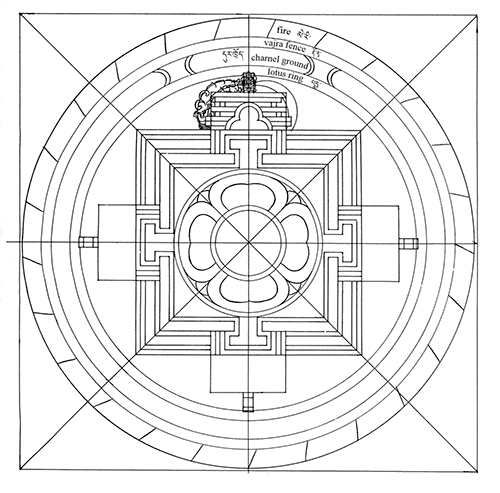
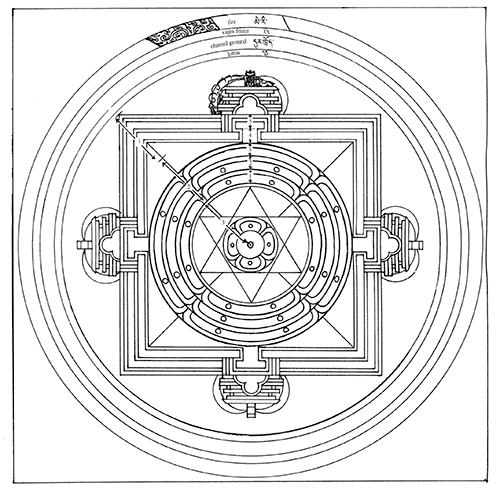
The Art of Awakening: A User’s Guide to Tibetan Buddhist Art and Practice
By Konchog Lhadrepa and Charlotte Davis
The sacred arts play an essential, intrinsic role in Tibetan Buddhist practice. Here, one of the great practitioners and master artists of our time presents a guide to the Tibetan Buddhist path, from preliminary practices through enlightenment, from the artist's perspective. With profound wisdom, he shows how visual representations of the sacred in paintings, sculptures, mandalas, and stupas can be an essential support to practice throughout the path. This work, based on the author's landmark Tibetan text, The Path to Liberation, includes basic Buddhist teachings and practices, clearly pointing out the relevance of these for both the sacred artist and the practitioner, along with an overview of the history and iconography of Buddhist art.
Dilgo Khyentse Rinpoche on Vajrayana and Dzogchen
While it is hard to categorize the works of a master like Dilgo Khyentse when a teaching on the so-called basics come from the highest possible view, there are three works that are explicitly on Vajrayana and Dzogchen.
The first is Pure Appearance: Development and Completion Stages in Vajrayana Practice, which is based on a set of teachings Rinpoche gave at Karma Dzong in Boulder, Colorado, shortly after officiating at the cremation of Chogyam Trungpa in 1987. This offers an overview of Tibetan tantric practice that explains its concepts, clarifies its terminology, and shows how its myriad pieces fit together, including an extensive teaching on the bardos, or “between states”—essential for those new to the topic and a source of illumination for longtime students.
After the teaching in Boulder, Rinpoche went to Halifax, Nova Scotia, and again taught, this time on Garab Dorje's famous text, Three Words That Strike the Vital Point, a vital Trekcho text. This was the basis for the book Primordial Purity: Oral Instructions on the Three Words That Strike the Vital Point. This text is based on the famous seminal statement by Garap Dorje that is said to encapsulate all the myriad dzogchen tantras. The key instructions on it by Patrul Rinpoche—the verses known as “The Special Teaching of Khepa Shri Gyalpo”—form the basis for the discourse in Primordial Purity. It explains that in dzogchen, when one has fully recognized that all the confusion of samsara is the expressive power of great emptiness, confusion is spontaneously liberated into the primordial purity of mind’s essential nature. Compassion spontaneously arises, accomplishing the benefit of sentient beings. Dilgo Khyentse Rinpoche illuminates this beautifully in this profound work, which will inspire students of Buddhism and deepen their experiential appreciation of the teachings.
The final work is a commentary on Mipham Rinpoche's The Lamp that Dispels the Darkness: Instructions That Point Directly to the Nature of Mind According to the Tradition of the Old Meditators found in Lion of Speech. Mipham Rinpoche, whom Khyentse Rinpoche said was Manjusri in human form, wrote this short text that really contains the whole of Dzogchen practice. Rinpoche said that Mipham Rinpoche's words fall into the category of martri, literally "red instructions," thus called "because they show the essential points of practice as if someone had opened his chest and shown the red of his heart."
$21.95 - Paperback
Pure Appearances: Development and Completion Stages in Vajrayana Practice
By Dilgo Khyentse Rinpoche
Translated by Ani Jinba Palmo
Translated by Nalanda Translation Committee
Edited by Nalanda Translation Committee
A complex topic is here made crystal clear through the heartfelt teaching of one of the great Tibetan Buddhist masters of the twentieth century. With Pure Appearance Dilgo Khyenste Rinpoche offers an overview of Tibetan tantric practice that explains its concepts, clarifies its terminology, and shows how its myriad pieces fit together, including an extensive teaching on the bardos, or “between states”—essential for those new to the topic and a source of illumination for longtime students. Read More
$18.95 - Paperback
Primordial Purity: Oral Instructions on the Three Words That Strike the Vital Point
By Dilgo Khyentse Rinpoche
Translated by Ani Jinba Palmo
Translated by Nalanda Translation Committee
Edited by Nalanda Translation Committee
The path of trekchö is the way of directly and thoroughly cutting through the misconceptions of samsara to lay bare the primordial purity of the nature of mind. This powerful practice is illuminated by Dilgo Khyentse Rinpoche in his commentary on an essential text based on the atiyoga dzogchen instructions of the outstanding nineteenth-century master Patrul Rinpoche. Read More
$27.95 - Hardcover
Lion of Speech: The Life of Mipham Rinpoche
Translated by Padmakara Translation Group
By Dilgo Khyentse Rinpoche
By Jamgon Mipham
Jamgön Mipham (1846–1912) is one of the great luminaries of Tibetan Buddhism in modern times. He has had a dominant and vitalizing influence on the Nyingma school in particular and, despite spending most of his life in retreat, is one of Tibet’s most prolific authors.
The first half of this volume comprises the first-ever English translation of the biography of Mipham Rinpoche written by Dilgo Khyentse Rinpoche, a teacher to His Holiness the Dalai Lama as well as an entire generation of other teachers and students throughout the Himalayan region and the West. Composed in 1939, it was left behind in Tibet in 1959 when Khyentse Rinpoche went into exile and was lost for fifty-one years before its discovery in 2010 by an extraordinary stroke of good luck. Reverential in tone, it is informed by both oral accounts preserved in notes kept by Khyentse Rinpoche’s elder brother and the recollections of Mipham’s devoted personal attendant of thirty-seven years. Read More
Other Works Related to Dilgo Khyentse Rinpoche
There are two other works in English should be mentioned here. The first is the recent On the Path to Enlightenment edited by Matthieu Ricard, which was inspired by Khyentse Rinpoche who features very prominently in it. The second is The Life of Shabkar, in which is found information about Khyentse Rinpoche's connection with this amazing nineteenth-century yogi. When he once stopped under a tree where Shabkar had sat singing songs of realization, the tree let down a shower of flowers on him, which Khyentse Rinpoche indicated to be a sign of a special karmic connection.
There are also a few short translations available online from the good folks at Lotsawa House.
Some words that Rinpoche wrote in his commentary to Jigme Lingpa's advice to those on retreat certainly applies to all his work: "as you read this precious text and my commentary on it, please do so with the perfect motivation of bodhicitta to establish all beings under the sky in the supreme level of the vajradharas and the profound view of the Mantrayana. "
Dilgo Khyentse's written works are in themselves a great treasure, but just as important a part of his legacy are the great teachers still with us who were educated at his feet, making the warmth of his realization still so present to all who yearn to practice for the benefit of all sentient beings.
$22.95 - Paperback
On the Path to Enlightenment: Heart Advice from the Great Tibetan Masters
Dilgo Khyentse Rinpoche inspired Matthieu Ricard to create this anthology by telling him that “when we come to appreciate the depth of the view of the eight great traditions [of Tibetan Buddhism] and also see that they all lead to the same goal without contradicting each other, we think, ‘Only ignorance can lead us to adopt a sectarian view.’” Ricard has selected and translated some of the most profound and inspiring teachings from across these traditions.
The selected teachings are taken from the sources of the traditions, including the Buddha himself, Nagarjuna, Guru Rinpoche, Atisha, Shantideva, and Asanga; from great masters of the past, including Thogme Zangpo, the Fifth Dalai Lama, Milarepa, Longchenpa, and Sakya Pandita; and from contemporary masters, including the Fourteenth Dalai Lama and Mingyur Rinpoche. They address such topics as the nature of the mind; the foundations of taking refuge, generating altruistic compassion, acquiring merit, and following a teacher; view, meditation, and action; and how to remove obstacles and make progress on the path.
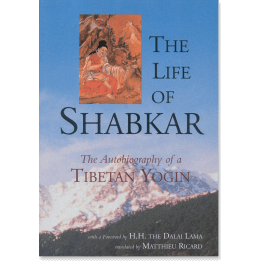
The Life of Shabkar: The Autobiography of a Tibetan Yogin
By Shabkar Tsogdruk Rangdrol
Translated by Matthieu Ricard
The Life of Shabkar has long been recognized by Tibetans as one of the masterworks of their religious heritage. Shabkar Tsogdruk Rangdrol devoted himself to many years of meditation in solitary retreat after his inspired youth and early training in the province of Amdo under the guidance of several extraordinary Buddhist masters. With determination and courage, he mastered the highest and most esoteric practices of the Tibetan tradition of the Great Perfection. He then wandered far and wide over the Himalayan region expressing his realization. Shabkar's autobiography vividly reflects the values and visionary imagery of Tibetan Buddhism, as well as the social and cultural life of early nineteenth-century Tibet.
Dilgo Khyentse's written works are in themselves a great treasure, but just as important a part of his legacy are the great teachers still with us who were educated at his feet, making the warmth of his realization still so present to all who yearn to practice for the benefit of all sentient beings.
Finally, here are some words that Rinpoche wrote in his commentary to Jigme Lingpa's advice to those on retreat certainly applies to all his work:
Discover more guides, articles, videos, and more

